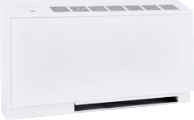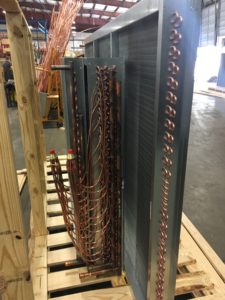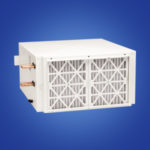1. A fan coil is among the easiest units to understand in the HVAC industry. Basically, there is a small forward curved fan, a coil, and sometimes a filter. They are all direct drive units. Click HERE to see Capital Coil’s full Fan Coil Product Lineup.
2. Fan coils run from 200 CFM to 2200 CFM, which is 0.5 ton through 5.5 tons. Anything larger than these sizes requires a belt drive unit…which is really a full fledged air handler.
3. The thing that differentiates fan coil units is where and how they are going to be installed. Is the unit going to be hidden above the ceiling or maybe in a closet? Or is it going to be exposed so that everyone can see it? Will it be ducted or will it just pull air from the space where it’s located? These are things that determine the configuration of the unit and which style of unit to choose. But, every unit has 3 things in common: fan, coil, and sometimes a filter.
 4. Some units have (2) coils. One for heating and one for cooling. Obviously, there is a separate supply and return connection for each coil and these units are known as 4 pipe fan coils. Many units only use the same coil for both heating and cooling and these units are 2 pipe fan coils.
4. Some units have (2) coils. One for heating and one for cooling. Obviously, there is a separate supply and return connection for each coil and these units are known as 4 pipe fan coils. Many units only use the same coil for both heating and cooling and these units are 2 pipe fan coils.
5. Units are either horizontal or vertical depending on the orientation and flow of the air. A typical fan coil in a hotel room is a vertical unit with a mixture of air coming from outside and the air recirculating in the room. The air enters at the bottom of the unit and is drawn upward through the fan. This makes the unit a vertical style. Many units are horizontal with the air entering at the back of the unit and traveling horizontally through the unit.
6. Almost all fan coils are 3 speed or infinite speed settings based on the controls. The high speed gives you more BTU’s, but more noise too. Because the unit is direct drive, when you dial down the speed, you also dial down the performance.
7. Coils in the units tend to be 3 or 4 row deep coils. 3 row is typically used the most, but if you need the extra performance, 4 row is the way to go. Performance is always governed by the cooling aspect.
8. Fan coils sometimes have short runs of duct work and there is static pressure on the unit. Static pressure reduces the amount of CFM and BTU’s that the fan coil can give you. This is true of both horizontal and vertical units. Most performances listed on charts that you will see are static free performances.
9. The control systems for fan coils are often more complicated and more expensive than the units themselves. There are balancing valves, isolation valves, unions, y-strainers, p/t plugs, air vents, ball valves, thermostats, condensate float switches, and disconnects. Capital Coil & Air can do this at the plant, but it is much cheaper and easier to do it at the installation.
10. Just describe your installation requirements to a sales engineer at Capital Coil & Air and they will guide you to the right design and configuration of the unit for you. It requires only a phone call or e-mail! We look forward to working with you!
RELATED POSTS
Top 10 Chilled Water Coil Facts
Light-Duty Commercial Belt Drive Air Handlers
Top 10 Questions You SHOULD Be Asking Your Coil Supplier



